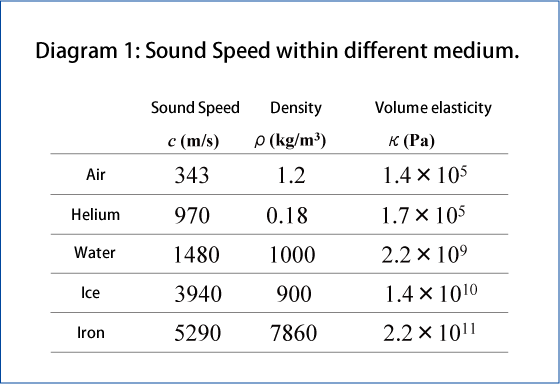- HOME
- Ono Sokki's Patio
- Sound Speed

Sound Speed
Ken: Renovation work has begun for our apartment.
Dad: It must be noisy during the day time.
Ken: The place they are renovating right now is far from our unit, but the sound seems as if it's nearby.
Dad: That's because sound travels very fast.
Ken: Doesn't sound travel about 340 meters per second?
Dad: That is when the sound travels through air.
Ken: Does sound travel through other than air?
Dad: It's awhile back we talked about solid borne sound and airborne sound. Do you remember?
Ken: Oh yeah. It is called solid borne sound when sound travels through concrete or the like.
Dad: Yes. I may not have explained it at that time, but the speed that sound travels depend on the medium, such as air, water, and iron.
Ken: I see. I can hear sound in a pool so sound travels not only in gas but liquid and solid. And, when you say the travel speed is different depending on medium, how different is it?
Dad: Look at this graph.
 (Table 1) (Roll cursor over here for picture)
(Table 1) (Roll cursor over here for picture)
Ken: Underwater is about 4 to 5 times faster compared to air. It's 15 times faster in iron! How come depending on the medium, the travel speed of sound is different?
Dad: You may never have heard of "volume elasticity". The sound speed can be expressed by the following equation using the volume elasticity and density.

Ken: Volume elasticity?
Dad: Air is an elastic body. An elastic body deforms when an external force is applied and returns to its original shape when the force is removed. If pressure is applied uniformly, it is compressed and its volume becomes smaller. When we call that pressure as "p" and the compressed volume per 1 m3 as "e", then p/e is the volume elasticity.
Ken: It is difficult but the value is the applied pressure divided by the compressed volume per 1 m3 when that pressure is applied. Are water and metal also elastic body?
Dad: Yes, it may be hard to imagine. The point is, when the volume elasticity value is large, it means that if you apply a certain pressure, its volume change is smaller, or in order to obtain the same volume change, it requires a larger pressure.
Ken: When you compare air and iron, air requires less pressure for a volume change, so it has low volume elasticity. Correct?
Dad: Yes. When you look at Equation (1), the volume elasticity is the numerator. So in relation to the sound speed, larger volume elasticity means greater the sound speed. Volume elasticity of air is 1.4 x 105 Pascal (Pa) and iron is 2.2 x 1011 Pa, so there's a 6-digit (106) difference between them.
Ken: But the sound speed is largely related to the density, or the denominator, isn't it?
Dad: Yes. Let's compare the density. Density of air is 1.2 kg/m3 and iron is 7860 kg/m3, so it's about 6500 times larger. In Equation (1), density is the denominator. The larger the density of the medium, the slower the sound speed. But when the volume elasticity is taken into consideration, sound speed in water is 4 to 5 times, and in iron is 15 times faster than that in air.
Ken: I see, that is why the construction sound appears to be nearby.
- © ONO SOKKI CO., LTD. 1996-2025
